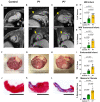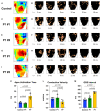Electrophysiologic Conservation of Epicardial Conduction Dynamics After Myocardial Infarction and Natural Heart Regeneration in Newborn Piglets
- PMID: 35355973
- PMCID: PMC8959497
- DOI: 10.3389/fcvm.2022.829546
Electrophysiologic Conservation of Epicardial Conduction Dynamics After Myocardial Infarction and Natural Heart Regeneration in Newborn Piglets
Abstract
Newborn mammals, including piglets, exhibit natural heart regeneration after myocardial infarction (MI) on postnatal day 1 (P1), but this ability is lost by postnatal day 7 (P7). The electrophysiologic properties of this naturally regenerated myocardium have not been examined. We hypothesized that epicardial conduction is preserved after P1 MI in piglets. Yorkshire-Landrace piglets underwent left anterior descending coronary artery ligation at age P1 (n = 6) or P7 (n = 7), After 7 weeks, cardiac magnetic resonance imaging was performed with late gadolinium enhancement for analysis of fibrosis. Epicardial conduction mapping was performed using custom 3D-printed high-resolution mapping arrays. Age- and weight-matched healthy pigs served as controls (n = 6). At the study endpoint, left ventricular (LV) ejection fraction was similar for controls and P1 pigs (46.4 ± 3.0% vs. 40.3 ± 4.9%, p = 0.132), but significantly depressed for P7 pigs (30.2 ± 6.6%, p < 0.001 vs. control). The percentage of LV myocardial volume consisting of fibrotic scar was 1.0 ± 0.4% in controls, 9.9 ± 4.4% in P1 pigs (p = 0.002 vs. control), and 17.3 ± 4.6% in P7 pigs (p < 0.001 vs. control, p = 0.007 vs. P1). Isochrone activation maps and apex activation time were similar between controls and P1 pigs (9.4 ± 1.6 vs. 7.8 ± 0.9 ms, p = 0.649), but significantly prolonged in P7 pigs (21.3 ± 5.1 ms, p < 0.001 vs. control, p < 0.001 vs. P1). Conduction velocity was similar between controls and P1 pigs (1.0 ± 0.2 vs. 1.1 ± 0.4 mm/ms, p = 0.852), but slower in P7 pigs (0.7 ± 0.2 mm/ms, p = 0.129 vs. control, p = 0.052 vs. P1). Overall, our data suggest that epicardial conduction dynamics are conserved in the setting of natural heart regeneration in piglets after P1 MI.
Keywords: conduction; electrophysiology; heart; mapping; myocardial infarction; neonate - age; regeneration.
Copyright © 2022 Wang, Pong, Obafemi, Lucian, Aparicio-Valenzuela, Tran, Mullis, Elde, Tada, Baker, Wang, Cyr, Paulsen, Zhu, Lee and Woo.
Conflict of interest statement
The authors declare that the research was conducted in the absence of any commercial or financial relationships that could be construed as a potential conflict of interest.
Figures




Similar articles
-
Multiaxial Lenticular Stress-Strain Relationship of Native Myocardium is Preserved by Infarct-Induced Natural Heart Regeneration in Neonatal Mice.Sci Rep. 2020 Apr 30;10(1):7319. doi: 10.1038/s41598-020-63324-w. Sci Rep. 2020. PMID: 32355240 Free PMC article.
-
A neonatal leporine model of age-dependent natural heart regeneration after myocardial infarction.J Thorac Cardiovasc Surg. 2022 Dec;164(6):e389-e405. doi: 10.1016/j.jtcvs.2021.08.013. Epub 2021 Aug 17. J Thorac Cardiovasc Surg. 2022. PMID: 34649718
-
Natural Heart Regeneration in a Neonatal Rat Myocardial Infarction Model.Cells. 2020 Jan 16;9(1):229. doi: 10.3390/cells9010229. Cells. 2020. PMID: 31963369 Free PMC article.
-
Anisotropic conduction characteristics in ischemia-reperfusion induced chronic myocardial infarction.Basic Res Cardiol. 1994 Mar-Apr;89(2):177-91. doi: 10.1007/BF00788736. Basic Res Cardiol. 1994. PMID: 8074641
-
P2Y12 antagonists and cardiac repair post-myocardial infarction: global and regional heart function analysis and molecular assessments in pigs.Cardiovasc Res. 2018 Dec 1;114(14):1860-1870. doi: 10.1093/cvr/cvy201. Cardiovasc Res. 2018. PMID: 30124783
Cited by
-
Cardiac conduction system regeneration prevents arrhythmias after myocardial infarction.Nat Cardiovasc Res. 2025 Feb;4(2):163-179. doi: 10.1038/s44161-024-00586-x. Epub 2025 Jan 3. Nat Cardiovasc Res. 2025. PMID: 39753976 Free PMC article.
-
Structural, angiogenic, and immune responses influencing myocardial regeneration: a glimpse into the crucible.NPJ Regen Med. 2024 Apr 30;9(1):18. doi: 10.1038/s41536-024-00357-z. NPJ Regen Med. 2024. PMID: 38688935 Free PMC article. Review.
-
Electrophysiological mapping of the epicardium via 3D-printed flexible arrays.Bioeng Transl Med. 2023 Jul 19;8(6):e10575. doi: 10.1002/btm2.10575. eCollection 2023 Nov. Bioeng Transl Med. 2023. PMID: 38023702 Free PMC article.
References
Grants and funding
LinkOut - more resources
Full Text Sources
Miscellaneous

